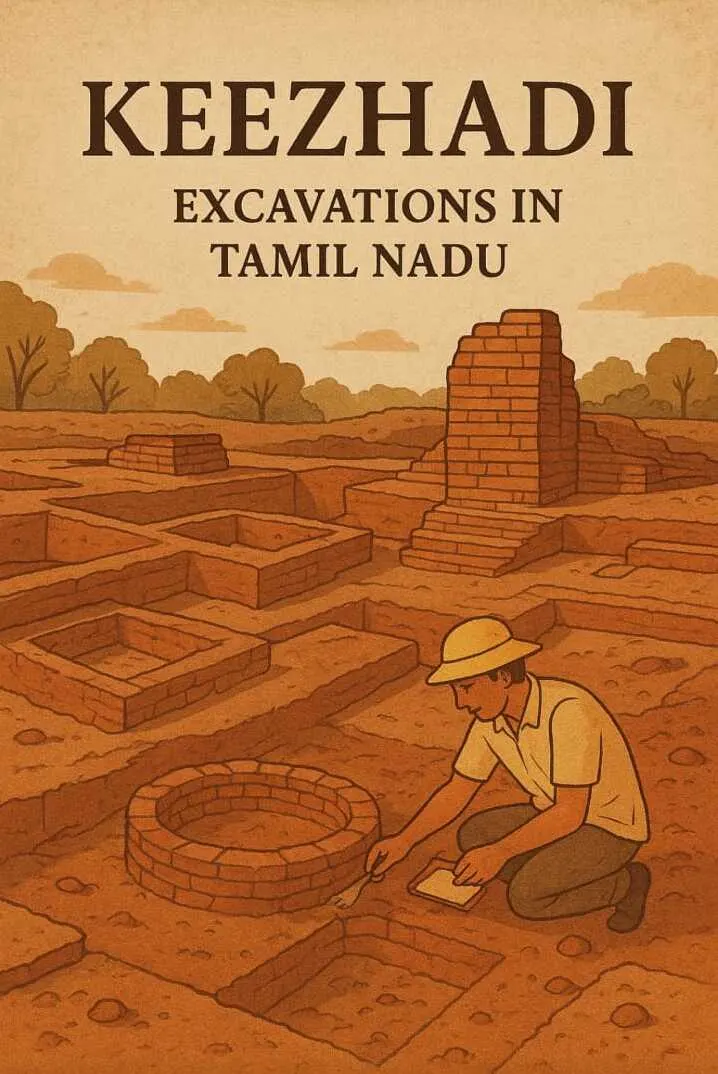| Title | KEEZHADI – A Fair Copy of the History of Civilization |
|---|---|
| Authors | J. Gayathri, and A. Amirthavalli |
| Category | Articles about Keezhadi excavation |
| Number of Pages | 5 |
| Language | English |
| File Size | 868, KB |
| File Type | |
| Country of Publication | India |
| Main Topics | Introduction, Geographical Location of Keezhadi, Early Explorations, Four Phases of Excavation From 2014 to 2018, Exploration of Cultural Reserves at Keezhadi, Key Findings- Potteries, Conclusion, References |
Summary Note of this Document
Uncovering Ancient Tamil Civilization and Sangam Age Secrets
In 2019, the Journal of Emerging Technologies and Innovative Research (JETIR) put out a paper by the Physics Department at D.K.M. College for Women (Autonomous) in Vellore, Tamil Nadu, India. This paper is about the important archaeological stuff found at the Keezhadi village dig site in the Sivaganga District of Tamil Nadu. The article authors point to the discoveries made at the place as the means to recast facts of the human civilization history by linking the site to the sangam period and suggesting that a highly developed urban Tamil culture has existed before or is comparable to Rakhigarhi and the Indus valley civilization.
What's interesting:
About the Keezhadi Site:
This place is situated close to the river Vaigai on the southern bank (around 9°N latitude, 78°E longitude) and measures about 110 acres. Preliminary explorations were actually done in the 1950s; however, a more planned organization to the Asi's digging operations was established in 2014 which was spread over five phases (2014-2019) (with the State Department of Archaeology, Tamil Nadu coordinating after).At the time of the paper's publication, the number of antiquities found from just 10% of the site was about 13,600, along with 293 points of the Vaigai river bank identified where excavations had been performed. These places were located by ASI, Tamil University, and other projects working together, and the collaboration so far had spread over districts of southern Tamil Nadu. There is scope for extending such partnerships further.
Phases of Excavation (2014–2018):
- Phase 1 (2015): As a result of digging 42 trenches, brick structures, iron tools, and earthenware dated approximately to the 3rd century BCE were revealed indicating trading with the local as well as other countries.
- Phase 2: The 59 quadrants led to the discovery of brick walls, rectangular chambers, corridors, tanks, and grooved tiles among other urban features representing old structures with the tiled roofs being hinted at by the groove on the tiles. Among the more than 8,000 objects found, most of them inscribed pottery of Tamil Brahmi script, a gold coin, a bead, and some jewelry suggested a civilization during the Sangam period (4th century BCE–2nd century CE) to be very prosperous and having trade relations with Rome.
- Phases 3–4 (2017): The work of the ASI and state expanded the area to 400+ square meters, the number of new objects found exceeded 7000, and the urban presence was confirmed.

|
Cultural Periods and Artifacts:
The above research divides the period into tentative phases based on Iron Age (before 300 BCE), Early Historic (300 BCE–300 CE) and Post Early Historic (after 300 CE), and even includes a Chola coin for the tenth century CE.
Structural Remains:
The evidence of advanced urban planning includes brick walls, drainage systems, terracotta ring wells.
Pottery:
The vast majority of the pottery was mainly of the local types such as coarse red ware, black and red ware (most of which had white painted designs), russet-coated painted ware, and rouletted ware. More than 70 Tamil Brahmi-inscribed pot sherds and 600 graffiti sherds are found signs of people's personal ownership markings. The very few foreign ceramics also show that there was strong local production of ceramics.
Other Finds:
These are gold ornaments, copper coins/objects, more than 4,000 beads (carnelian, agate, glass, semiprecious stones), ivory items, shell bangles, combs, and terracotta figures. These represent agricultural and industrial activities like ironworking, carpentry, pottery, and spinning-weaving besides the internally traded network of goods.
Significance and Implications:
As highlighted by the site, Tamil was a literate society of urban character which had links with the rest of India and even other international civilizations. The dating by carbon of the samples pushes the beginning of Tamil Brahmi to the 6th century BCE which is at variance with the standard Sangam Age timeline (3rd century BCE–3rd century CE). There is a call among the authors for more excavations, usage of high-tech instruments (while noting dependence on foreign laboratories such as the U.S. and Italy), and the joint effort of historians, students, and institutions in finding more that could mean rewriting of ancient Tamil history.
Conclusion:
The implements found from Keezhadi bring out the splendour of an ancient lifestyle and could be a "treasure of knowledge" if fully explored, stressing the need for collective involvement of the public and academics.
This paper is also the first of many references made to reports of the ASI, government publications, and news articles (e.g. The Hindu, Times of India) which establish the role played by the site in verifying the early urban heritage of Tamil Nadu.
